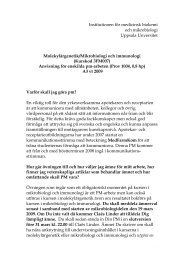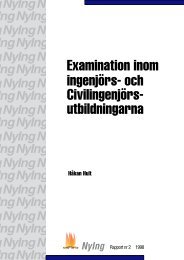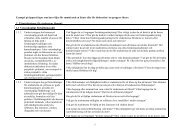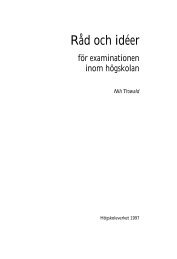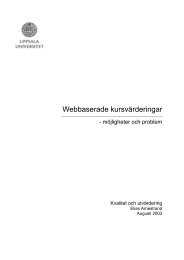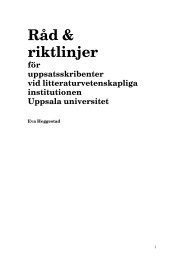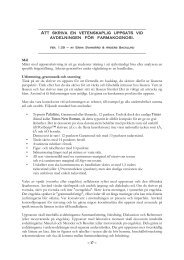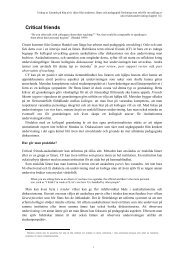Aligning teaching and assessment to curriculum objectives John Biggs
Aligning teaching and assessment to curriculum objectives John Biggs
Aligning teaching and assessment to curriculum objectives John Biggs
You also want an ePaper? Increase the reach of your titles
YUMPU automatically turns print PDFs into web optimized ePapers that Google loves.
Extended underst<strong>and</strong>ing, being able <strong>to</strong> gobeyond what has been taught, deal creativelywith new situations: Apply <strong>to</strong> novel contexts,hypothesize, reflect, generate.The first step in designing the <strong>curriculum</strong><strong>objectives</strong>, then, is <strong>to</strong> make clear what levels ofunderst<strong>and</strong>ing we want from our students inwhat <strong>to</strong>pics.Once we have done that, we need <strong>to</strong> decide howwe are going <strong>to</strong> get them <strong>to</strong> do it. Those verbs,<strong>and</strong> others that suit your own discipline,become the markers throughout the system.They need <strong>to</strong> be embedded in the<strong>teaching</strong>/learning activities, <strong>and</strong> in the<strong>assessment</strong> tasks. They keep us on track.Choosing <strong>teaching</strong>/learningactivities (TLAs)We usually take TLAs for granted. The defaultTLAs in many courses are lecture <strong>and</strong> tu<strong>to</strong>rial:lecture <strong>to</strong> expound <strong>and</strong> package, <strong>and</strong> tu<strong>to</strong>rial <strong>to</strong>clarify <strong>and</strong> extend. However, the verbs thesecontexts elicit are not necessarily high level ifthe student is not so inclined. Students can getaway with being passive, whereas high levellearning requires them <strong>to</strong> be active in theirlearning.There are many options for creatingappropriate learning contexts (Chapter 5, <strong>Biggs</strong>2003) but even the large class allows a widerange of relevant student activity – if only thelecturer s<strong>to</strong>ps talking now <strong>and</strong> then, <strong>and</strong>requires students <strong>to</strong> question each other aboutjust taught content, <strong>to</strong> reflect, <strong>to</strong> swap notes,<strong>to</strong> do exercises, <strong>to</strong> self-test, <strong>and</strong> so on (seeChapter 6, op. cit.). Then of course there is arange of activities that can be scheduledoutside the classroom, especially but not onlyusing IT (Chapter 10, op cit.). In fact, problemsof resourcing conventional on campus <strong>teaching</strong>,<strong>and</strong> the changing nature of HE, are coming <strong>to</strong>be blessings in disguise, forcing learning <strong>to</strong> takeplace outside the class, with group <strong>and</strong> peer<strong>teaching</strong>, independent learning <strong>and</strong> work-basedlearning, all of which are a rich source ofrelevant learning activities.Assessing students’ learning outcomesIt is no exaggeration <strong>to</strong> say that faultyassumptions <strong>and</strong> practices about <strong>assessment</strong> domore damage than any other single fac<strong>to</strong>r. AsRamsden (1992) puts it, the <strong>assessment</strong> is the<strong>curriculum</strong>, as far as the students areconcerned. They’ll learn what they think they’llbe assessed on, not what’s in the <strong>curriculum</strong>, orwhat’s been ‘covered’ in class.The trick is, then, <strong>to</strong> make sure the <strong>assessment</strong>tasks mirror what you intended them <strong>to</strong> learn.That pre-empts the sort of cynical gameplayingwe saw in our psychology undergraduate,above, with his ‘two pages of writing’.But there’s a much broader problem, whichmust be addressed full-on. The fact is, themost common <strong>assessment</strong> practices make suchalignment all but impossible.Two approaches <strong>to</strong> <strong>assessment</strong>Two approaches <strong>to</strong> <strong>assessment</strong> underlie currenteducational practice. The first is thetraditional model. We teach, then we test.Next, we order students along a quantitativescale, usually a percentage scale, which is doneby the familiar process of ‘marking’, <strong>and</strong> thenwe allocate grades. Grading can be carried outby stipulating arbitrary cut-off points: 75+becomes an A, 65 – 74, B, <strong>and</strong> so on. A commonalternative is <strong>to</strong> grade on the curve or <strong>to</strong> normreference.That is, the <strong>to</strong>p 15 per cent, say, areawarded A; the next 25 per cent B, <strong>and</strong> so on.In either method of grading, the commonfeature is that the students’ performanceshave <strong>to</strong> be quantified. Quantification isachieved in one or both of two ways. First,knowledge is broken down in<strong>to</strong> units that areclassified as correct or incorrect, <strong>and</strong> thecorrect units are added or averaged. Second, a



